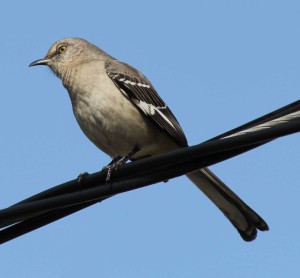Northern Mockingbird
Recently, on a visit to Long Island, NY, I sat in a kitchen listening to what seemed like a flock of different song birds singing away right outside a window in a holly bush. It was no surprise to walk outside and see a Northern Mockingbird sitting on the top of the bush switching its tune over and over.
Description:
The northern mockingbird is a medium-sized songbird, a bit more slender than a thrush with a longer tail. Mockingbirds have small heads, a long, thin dark bill with a downward curve at the tip and long legs. Their wings are short, rounded, and broad, making the tail seem particularly long in flight. Both males and females look alike.
The Mockingbird is overall gray-brown, paler on the breast and belly. As the picture indicates, mockingbirds have two white wingbars on each wing. A white patch in each wing is often visible on perched birds, and in flight these become large white flashes. The white outer tail feathers are clear when the birds are in flight.
Mockingbirds are approximately 8.3” – 10.2” long with a wingspan of 12.2” – 13.8”. They weigh about 1.6 – 2 oz. As a comparison, northern mockingbirds are slightly smaller than a common grackle
Habitat:
The northern mockingbird can be found in towns, suburbs, backyards, parks, forest edges, and open land at low elevations. They usually reside in fields and forest edges, usually seen in farmlands, roadsides, city parks, suburban areas, and open grassy areas with thickets and brushy deserts
Food:
The northern mockingbird is an omnivore. They eat mainly insects in summer but switch to eating mostly fruit in fall and winter. Among their animal prey are beetles, earthworms, moths, butterflies, ants, bees, wasps, grasshoppers, and small lizards. They eat a wide variety of berries and fruits. They’ve been seen drinking sap from the cuts on recently pruned trees.
Territory:
The mockingbirds’ breeding range is from Maritime provinces of Canada westwards to British Columbia, practically the entire Continental United States, and the majority of Mexico to eastern Oaxaca and Veracruz. The mockingbird is generally a year-round resident of its range, but the birds that live in the northern portion of its range have been noted further south during the winter season. The bird can most frequently be found in the Southern United States
Read more about animals at: www.grizzlyrun.com